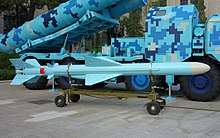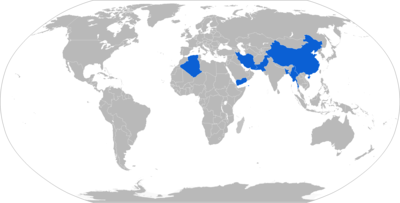YJ-83
The YJ-83 (Chinese: 鹰击-83; pinyin: yingji-83; lit.: 'eagle strike 83'; NATO reporting name: CSS-N-8 Saccade) is a Chinese subsonic anti-ship cruise missile. It is manufactured by the China Aerospace Science and Industry Corporation Third Academy.[1]
| YJ-83 | |
|---|---|
 YJ-83J Missile | |
| Type | Anti-ship cruise missile |
| Place of origin | People's Republic of China |
| Service history | |
| In service | 1998 |
| Used by | People's Republic of China |
| Production history | |
| Manufacturer | China Aerospace Science and Industry Corporation |
| Specifications | |
| Warhead | 190 kg high-explosive fragmentation |
| Engine | CTJ-2 turbojet |
Operational range | 180 km (YJ-83) 200 km (YJ-83K) 120 km (C-802) 190 km (C-802A) |
| Maximum speed | Mach 0.9 |
Guidance system | Inertial navigation/active radar homing terminal guidance |
Launch platform | Surface |
Description
The YJ-83 uses microprocessors and a strapdown inertial reference unit (IRU); these are more compact than the equivalent electronics used in the YJ-8 and the export C-802, allowing the YJ-83 to have a 180-km range at Mach 0.9. The missile is powered by the Chinese CTJ-2 turbojet, and carries 190-kg high-explosive fragmentation warhead. Terminal guidance is by an active radar.[1] The YJ-83K, the air-launched variant, has a range of 200 km.[2] This data may be for an improved YJ-83A; the original YJ-83 may have shorter range, at 120 km and 130 km for the surface- and air-launched versions, respectively.[1]
The YJ-83KH has an electro-optical seeker, and may receive course corrections by remote link.[3]
The YJ-83 entered service with the People's Liberation Army Navy in 1998-1999[1] and has equipped a large number of its surface warships.[4] The YJ-83K equips the Chengdu J-10[5], Xian JH-7 and H-6G.[2]
C-802

The C-802 is the export version of the YJ-83;[4] It is powered by the French TRI 60-2 turbojet[1] and has a range of 65 nautical miles (120 km).[4]
The C-802A and C-802AK are the export surface- and air-launched variants.[1] The C-802A has a range of 100 nautical miles (190 km).[4]
Confusion between the YJ-82, C-802 and "C-803"
The US military considers the C-802 and C-802A as parts of the YJ-83 family.[4]
The C-802 precedes the closely related YJ-83; strictly speaking, only the C-802A is the export development of the YJ-83.[6] The C-802 is sometimes and erroneously considered the export version of the YJ-82; the two are separate developments.[7]
A prospective "C-803" was erroneously promulgated as the export version of the YJ-83 by enthusiasts in the late-1990s.[6] As yet, no such missile exists.
Operational history
News reports indicate that this was the missile used[8] on 14 July 2006, in the 2006 Lebanon War when Hezbollah fired two missiles at Israeli warships.[9][10] One missile hit the corvette INS Hanit, causing significant damage and four fatalities.[11] Iran, the reported supplier of the missile to Hezbollah, refused to formally confirm or deny the claim. The Hanit suffered severe damage, but stayed afloat, got itself out of the line of fire, and made the rest of the journey back to Ashdod for repairs on its own.[12]
The Israeli ship possessed sophisticated multi-layered missile defense capability: a Phalanx CIWS gun, Barak 1 anti-missile missiles, Chaff and ECM. These should have been able to prevent an anti-ship missile attack such as the YJ-82, but according to the Israeli military, these were intentionally disabled at the time of the alleged missile hit due to:[13]
- Lack of intelligence indicating Hezbollah possessed such a missile.[13]
- Presence of many Israeli Air Force aircraft conducting operations in the vicinity of the ship which might have accidentally set off the ship's anti-missile/aerial threats system, with the danger of shooting down a friendly aircraft. However, the ship has an (optionally installed, especially during wartime) Identification friend or foe interrogator system to prevent attacking friendly aircraft.
On 9 October 2016, the United States Navy guided-missile destroyer USS Mason (DDG-87) reported coming under attack in the Red Sea by cruise missiles fired from territory in Yemen controlled by the Houthi group. The missiles appeared similar to one fired from Yemen a week earlier that damaged HSV Swift, a leased transport ship under the control of the United Arab Emirates, who are supporting the Yemeni government in a civil war against the Houthis. Analysis of the damage caused by that missile led experts to believe it was a C-802. None of the missiles fired at USS Mason hit their targets; U.S. authorities claimed that defensive countermeasures were used, including firing defensive missiles.[14][15]
Operators

- Algerian National Navy, C-802[16]
- Bangladesh Navy, C-802[17]
- Myanmar Navy, C-802[19]
- Myanmar Air Force, C-802AK[20]
- Pakistan Air Force, C-802[21]
- Pakistan Navy, C-802[21]
- Yemeni Navy, C-802[23]
References
- Gromley et al.: page 101
- United States Office of the Secretary of Defense (8 May 2015). Annual Report To Congress: Military and Security Developments Involving the People's Republic of China 2015 (PDF) (Report). p. 46. Archived (PDF) from the original on 14 May 2015. Retrieved 24 January 2015.
- Gromley et al.: page 102
- United States Office of Naval Intelligence: page 16
- "J-10 (Jian 10) Vigorous Dragon Multirole Tactical Fighter". Air Force Technology. January 2020. Retrieved 10 May 2020.
- Carlson, Christopher P. (8 February 2013). "China's Eagle Strike-Eight Anti-Ship Cruise Missiles, Part 3". DefenseMediaNetwork. Archived from the original on 3 June 2016. Retrieved 21 April 2016.
- Carlson, Christopher P. (6 February 2013). "China's Eagle Strike-Eight Anti-Ship Cruise Missiles, Part 2". DefenseMediaNetwork. Archived from the original on 4 March 2016. Retrieved 21 April 2016.
- Mazzetti, Mark (1 January 2009). "Striking Deep Into Israel, Hamas Employs an Upgraded Arsenal". The New York Times. Archived from the original on 17 April 2009. Retrieved 12 August 2018.
- "DEBKAfile, Political Analysis, Espionage, Terrorism, Security". Archived from the original on 2 September 2009. Retrieved 8 October 2015.
- Thomson Reuters Foundation. "Thomson Reuters Foundation". Retrieved 8 October 2015.
- "IDF Finds Bodies of Missing Sailors Aboard Damaged Navy Ship". Haaretz.com. Archived from the original on 18 July 2006. Retrieved 8 October 2015.
- "Strike on Israeli Navy Ship". NAVSEA. 19 July 2006. Archived from the original on 11 February 2007.
- Greenberg, Hanan (1 January 2007). "Officers reprimanded over Hanit vessel incident". Ynet.
- "USS Mason Fired 3 Missiles to Defend From Yemen Cruise Missiles Attack". USNI. 11 October 2016. Archived from the original on 9 August 2018. Retrieved 12 August 2018.
- "U.S. Navy ship targeted in failed missile attack from Yemen: U.S." NAVSEA. 10 September 2016.
- Rahmat, Ridzwan (16 March 2016). "Algeria commissions second Chinese-built C28A corvette". IHS Jane's 360. Archived from the original on 20 April 2016. Retrieved 20 April 2016.
- "Bangladesh Navy successfully test fires long range missile". The Daily Star. Archived from the original on 17 April 2016. Retrieved 5 April 2016.
- "C-802 / YJ-2 / Ying Ji-802 / CSS-C-8 / SACCADE / C-8xx / YJ-22 / YJ-82". GlobalSecurity.org. Archived from the original on 18 May 2019. Retrieved 29 April 2019.
- Mazumdar, Mrityunjoy (29 December 2015). "Myanmar commissions second frigate with reduced RCS, hospital ship". IHS Jane's 360. Archived from the original on 31 December 2015. Retrieved 20 April 2016.
- "SIPRI Trade Register". Stockholm International Peace Research Institute.
- Dominguez, Gabriel (6 March 2018). "PN, PAF successfully test-fire C-802 anti-ship cruise missiles". IHS Jane's 360. Archived from the original on 12 August 2018. Retrieved 12 August 2018.
- United States Office of Naval Intelligence: page 17
- Binnie, Jeremy (29 October 2015). "Yemeni rebels claim third anti-ship missile attack". IHS Jane's 360. Archived from the original on 8 April 2016. Retrieved 20 April 2016.
| Wikimedia Commons has media related to YJ-83. |
- Bibliography
- Gormley, Dennis M.; Erickson, Andrew S.; Yuan, Jingdong (30 September 2014). "A Potent Vector: Assessing Chinese Cruise Missile Developments". Joint Forces Quarterly. National Defense University (75). Retrieved 8 May 2015.
- United States Navy Office of Naval Intelligence (2015). The PLA Navy: New Capabilities and Missions for the 21st Century (PDF) (Report). Archived from the original (PDF) on 18 May 2015. Retrieved 9 May 2015.